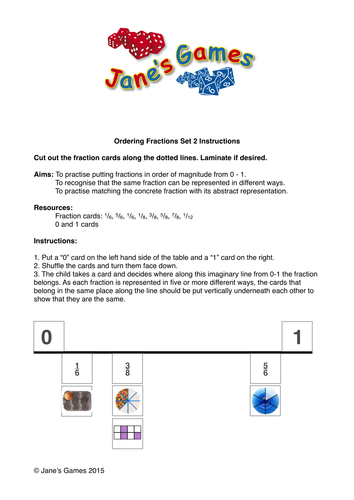



This activity reinforces what fractions mean. Children arrange the 42 cards in each set along a line from 0-1. For example, which side of ¾ does 7/8 go? Why? A given fraction is illustrated in different ways: as a number; as a picture of a familiar object, such as half an apple or pizza; as a diagram or as a fraction of a whole number such as half a box of 6 eggs. There are four sets at different levels which I have listed separately because the file sizes are huge.
Set 1 1⁄2, 1⁄4, 3⁄4, 1⁄3 ,2⁄3, 1⁄5, 1
Set 2 1⁄6, 5⁄6, 1⁄8, 3⁄8, 5⁄8, 7⁄8, 1⁄12
Set 3 Equivalent fractions: 1⁄2, 1⁄4, 3⁄4, 1⁄3, 2⁄3, 1⁄5, 4⁄5
Set 4 Equivalent fractions, including decimals and percentages 1⁄2, 1⁄4, 3⁄4, 1⁄5, 4⁄5, 1⁄8, 1⁄10,
The equivalent fractions help to explain how the same value may appear in different forms. In set 3, 1⁄2 can be matched with 2⁄4, 3⁄6, 4⁄8, and 5⁄10, for example.
Set 4 introduces the idea that the same value can appear as a fraction, as a decimal or as a percentage. 1⁄2 can be matched with 0.5 and 50% as well as with 3/6 of a box of eggs, for example.
Get this resource as part of a bundle and save up to 50%
A bundle is a package of resources grouped together to teach a particular topic, or a series of lessons, in one place.
Something went wrong, please try again later.
This resource hasn't been reviewed yet
To ensure quality for our reviews, only customers who have purchased this resource can review it
Report this resourceto let us know if it violates our terms and conditions.
Our customer service team will review your report and will be in touch.